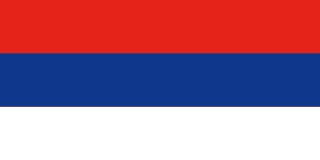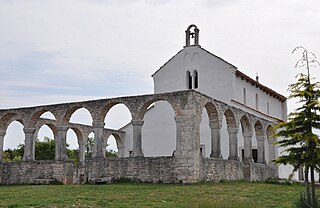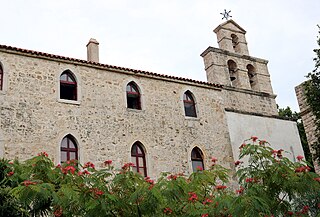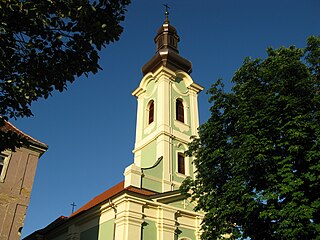
The Ustaše, also known by anglicised versions Ustasha or Ustashe, was a Croatian, fascist and ultranationalist organization active, as one organization, between 1929 and 1945, formally known as the Ustaša – Croatian Revolutionary Movement. From its inception and before the Second World War, the organization engaged in a series of terrorist activities against the Kingdom of Yugoslavia, including collaborating with IMRO to assassinate King Alexander I of Yugoslavia in 1934. During World War II in Yugoslavia, the Ustaše went on to perpetrate the Holocaust and genocide against its Jewish, Serb and Roma populations, killing hundreds of thousands of Serbs, Jews, Roma, as well as Muslim and Croat political dissidents.

Nova Gradiška is a town located in the Brod-Posavina County of Croatia, population 14,229 (2011). It is located in the historic region of Slavonia, near the border to Bosnia and Herzegovina.

The Croatian Orthodox Church was a religious body created during World War II by the Fascist Ustaše regime in the Independent State of Croatia (NDH). It was created in order to assimilate the remaining Serb minority and also to unite other Orthodox communities into a state-based Greek Orthodox Church.

The Serbs of Croatia or Croatian Serbs constitute the largest national minority in Croatia. The community is predominantly Eastern Orthodox Christian by religion, as opposed to the Croats who are Catholic.

Negoslavci is a village and a municipality in Vukovar-Syrmia County in eastern Croatia. It is located south of the town of Vukovar, seat of the county. Landscape of the Negoslavci Municipality is marked by the Pannonian Basin plains and agricultural fields of maize, wheat, common sunflower and sugar beet.
Civljane is a village and municipality in Šibenik-Knin County, Croatia. With only 239 inhabitants, it is the smallest municipality in Croatia by population. Civljane is an underdeveloped municipality which is statistically classified as the First Category Area of Special State Concern by the Government of Croatia.

The Genocide of Serbs in the Independent State of Croatia was the systematic persecution and extermination of Serbs committed during World War II by the fascist Ustaše regime in the Nazi German puppet state known as the Independent State of Croatia between 1941 and 1945. It was carried out through executions in death camps, as well as through mass murder, ethnic cleansing, deportations, forced conversions, and war rape. This genocide was simultaneously carried out with the Holocaust in the NDH as well as the genocide of Roma, by combining Nazi racial policies with the ultimate goal of creating an ethnically pure Greater Croatia.

The Lepavina Monastery is a Serbian Orthodox monastery dedicated to the Presentation of Mary and located at the village of Sokolovac, near the town of Koprivnica in Croatia.

Peroj is a village in the Town of Vodnjan-Dignano on the southwestern coast of Istria, Croatia. Peroj originally dates back to the Copper Age of prehistory, as testified by a necropolis within the old walls of the village. The village has been settled by families from a variety of origins throughout its history. During the occupation of the Romans, the town was named Pedrolo, and was a popular holiday destination.

The Krupa Monastery is a Serbian Orthodox monastery on the Krupa River in Croatia. It is one of the oldest Orthodox monasteries in Croatia, alongside Krka and Dragović monasteries.

The Cathedral of the Transfiguration of the Lord is a Serbian Orthodox cathedral located on the Petar Preradović Square in Zagreb, Croatia. It was built in 1865–66 according to designs of architect Franjo Klein. It is ecclesiastically part of the Metropolitanate of Zagreb and Ljubljana and is known as the Zagreb Orthodox Cathedral. Due to 2020 Zagreb earthquake the Cathedral went to re-construction due to mayor damages that occurred.

The Church of St. George in Bobota is Serbian Orthodox church in eastern Croatia. The church is famous for its icons in the iconostasis that were painted in 1778. During the Croatian War of Independence, administration of Eparchy of Osječko polje and Baranja sent the icons on the restoration and preservation in Vojvodina. The icons were returned to the church after the end of war. The decision to remove the cultural property from the church caused controversy and was an open issue in Croatia–Serbia relations up until the final return of icons.

The Church of the Holy Annunciation is a Serbian Orthodox church in Dubrovnik, south Croatia. It was built in 1877.

The Church of the Intercession of the Holy Virgin in Knin is a Serbian Orthodox Church in Šibenik-Knin County, Croatia. The church was built in the neo-Byzantine style in the 18th century.

The Church of St. Nicholas or Karlovac Cathedral, is a Serbian Orthodox church located in Karlovac, in central Croatia. The original church was finished in 1787, and was dedicated to Saint Nicholas. In 2007, the church was completely renovated.

Church of St. Nicholas in Mirkovci is Serbian Orthodox church in eastern Croatia.

Porfirije is the current and 46th patriarch of the Serbian Orthodox Church. He was the Metropolitan Bishop of Zagreb and Ljubljana from 2014 to 2021 and Titular Bishop of Jegra between 1999 and 2014. He is also a university professor and author of theological works.

The Church of the Dormition of the Mother of God is a Serbian Orthodox church located in Donji grad, Osijek in eastern Croatia. The modern day church was completed in 1979 at the site of an earlier Serbian Orthodox church which was destroyed by the Ustashe regime in 1942 during the World War II Genocide of Serbs in the Independent State of Croatia.

The Church of St. George in Opatovac is Serbian Orthodox church in eastern Croatia. Church was built in 1802 with the iconostasis is from 1769. The church is located in the centre of the village next to the main D2 road between Vukovar and Bačka Palanka.


























